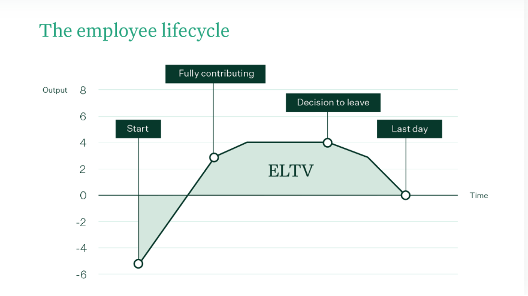Recruitment Metrics Every SME Should Track

Metrics are essential for every business, but recruitment metrics can help an SME business stay ahead of its competitors and control hiring costs. This blog will discuss the importance of metrics, how they can support a recruitment strategy, and some examples of different types of metrics.
What are recruiting metrics?
Recruiting metrics track hiring success and optimise the process of hiring top talent for the business. Additionally, key recruitment metrics provide organisations with data that enables them to improve their recruitment strategy and process.
Making the right recruiting decisions is important to any organisation; hiring someone who is more suited for the job has the potential to create an enormous return on investment (ROI).
Employee lifetime value formula
Employee lifetime value (ELTV) represents the total net value over time that an employee brings to a business. The graph below illustrates this concept in terms of the employee lifecycle. The X-axis represents time, spanning from the start date to the day the employee leaves, and the Y-axis represents the employee output.

This type of data is useful in refining a company’s people strategy. However, when considering recruitment, employers want to ensure that they are recruiting the right candidates so that they get a return on the recruitment investment. Getting the wrong candidates can be costly if employees leave before they fully contribute to the business.
What is a recruitment strategy?
A recruitment strategy is a key plan for how businesses will find and hire the best talent for their positions. It should take into account the organisation’s current and future staffing needs, aligning with the overall business objective and market conditions.
Defining the specific skills, behaviours and experience required for the roles and preparation of job descriptions.
Understanding the marketplace is key a tight, marketplace is where the demand for skills exceeds the supply and is often seen as a candidate driven marketplace. It’s important to have a good strategy in place defining where organisations can find talent, the different tools they will use, ensuring that the candidate’s experience is positive with frequent communication.
What are some common recruiting metrics?
There a number of metrics organisations can use, its important to use metrics that are meaningful to the business and will give it the information requited to improve the processes. Hiring quality talent is crucial for small businesses as each employee can significantly impact overall performance.
Time to fill – this refers to the number of calendar days it takes to find and hire a new employee; this is often measured by the number of days between approving a job posting and the candidate accepting the role. There are a number of factors that may impact this metric, such as the marketplace, hiring managers, and the types of roles you are hiring for. Using this data to support the recruitment strategy is key. If the metrics highlight that the marketplace is tight due to a lack of candidates, organisations can refine their search methods.
Time hire – this represents the number of days between the moment a candidate applies and the moment they accept the role offer. In essence, this is the time it takes a candidate to go through the hiring process once they have applied. This metric is important as it could highlight areas within the recruitment application process where there are potential bottlenecks. By applying this metric to hiring teams or managers will help identify where the bottlenecks are and help businesses implement improvements in the hiring process.
Source of hire – Tracking the sources of new hires is a popular and incredibly useful metric. This metric helps businesses track the effectiveness of using different recruiting channels, these can be job posting boards, LinkedIn, the business career page, social media and recruitment agencies.
Sourcing channel effectiveness – This will tell you the percentage of candidates sourced from a particular channel. This compares the percentage of applications with the percentage of impressions of the job posting. You can use Google Analytics to track where the potential candidates who viewed the job posting on your website or careers page come from.
Sourcing channel costs—Budgets are key, and for small businesses, keeping track of the cost of recruitment is vital. It is easy to calculate this: By dividing the advertising spend by the number of visitors who applied through the job opening, you measure the sourcing channel cost per hire.
Retention rates – this measurement is the percentage of employees who remain employed over a specific period of time. This indicates the success of the businesses’ HR practices.
The calculation is: (Number of employees at the end of a set period / the number of employees at the start of a set time period) x 100 = retention rate percentage.
Cost per hire – this is the total cost incurred when hiring a new employee. It includes the advertisement cost and any subscriptions to software, such as LinkedIn Recruiter or Applicant Tracker Systems (ATS). Tracking this and using it to guide budgets for future hires can help understand the financial impact of hiring.
Offer acceptance rate – this is the percentage of accepted offers made to candidates. This is an important measure. If an organisation has a low offer acceptance rate, it could indicate some issues with the package, candidate experience or even company reputation.
To understand the offer acceptance rate: (number of offers accepted/ total offers extended) x 100
Quality of hire – This is a measurement of new employees’ performance during the first year. Employees who receive a high-performance rating are deemed as hiring success. Whereas a low performance rating or an employee who doesn’t pass probation is deemed as a bad hire. Unsuccessful hires can cost the business up to three times the annual salary (Greedy, n.d.)
Candidate experience – this is also another key measure, which can be assessed through candidate feedback, surveys or if you are using an ATS through the platform. Having access to this data is fundamental to developing a concise and exceptional experience for candidates, not just the application process but interviewing process, time to receive feedback and the quality of feedback. Having this data enables the business to refine the process and attract the best talent to the business.
“MAD-HR are a great partner”
“MAD-HR are a great partner. The team are knowledgeable, supportive and really take the time to understand our organisation.” Read the full review
How can I track recruiting metrics?
Decide which metrics work for the business or organisation based on the company size and available resources (the last thing any organisation needs is to make a work out of something that should be simple). The hiring goals and which metric is most crucial to the business recruitment strategy.
Applicant Tracker System (ATS) – The majority of ATS automatically track a variety of data, which organisations can use to measure the success of their recruitment strategies.
Jobs boards – using an established jobs board can also give a business some analytics on traffic and reach of candidates. Use this data to evaluate the effectiveness of each od the jobs boards used.
Integrating analytical tools – using platforms like Power BI and Google Analytics can aid organisations in providing deeper insight to the data and creating dashboards that make it easy to monitor trends and enable the business to make data driven decisions.
Using spreadsheets form manual tracking – setting up a manual tracking spreadsheet using Excel or Google Sheets, can also provide data and enable organisation to make data driven decisions.
In conclusion, it is crucial to track the right metrics for the business. Doing this can improve candidate experience, and make data driven decisions. Businesses can identify bottlenecks in the recruitment process and allocate resources effectively.
It doesn’t matter the size of the business regularly analysing the metrics they can enhance efficiency of their hiring efforts and support strategic growth, improve retention and build a diverse high performing team.
The continuous monitoring and refinement of recruitment metrics enable companies to remain competitive in the talent market, ensuring they bringing on board the very best candidates who will drive long term success.
If you would like to know more about these metrics and how to start effectively implementing them in your business as part of your recruitment process, please get in touch with our team today.
The content of this article is for general information only. It is not, and should not be taken as, legal advice. If you require any further information in relation to this article please contact us.
There may be occasions where the articles contain links to external websites. We have no control over the nature, content and availability of those sites. The inclusion of such links does imply a recommendation or endorse the views expressed within them.



